“The Last of Us” Production Designer John Paino on Building a World in Ruins
“I’ve noticed an uptick in mushroom articles,” production designer John Paino jokes. So have I, actually, but it might be a case of being suddenly aware of the ubiquity and centrality of fungi to the living world ever since HBO’s The Last of Us premiered. The series, based on the critically acclaimed video game by Naughty Dog, asks us to look afresh at the fungus and fear. It presents a world in which fungi, specifically the Cordyceps genus (it includes some 600 species), has infiltrated the human body and mind, turning formerly healthy people into a variety of zombies nearly as variable as the fungus kingdom itself (there are an estimated 2.2 to 3.8 million species, but nobody knows for sure—only 148,000 have been identified). Co-created by Chernobyl visionary Craig Mazin and Neil Druckmann, the man who dreamed this nightmare into existence for Naughty Dog, The Last of Us is making a very strong case for being one of the best zombie stories of all time and, by a wide margin, the best video game adaptation, ever.
Paino was aware of the game, of course, as were all the creatives who came onboard Mazin and Druckmann’s series, but he didn’t log the necessary hours to really take it on. “It’s so engrossing that you really have to take the time to devote your life to it,” he says. Yet he was a major fan of was the game’s concept art, from which he began developing his ideas on how to create a world in which fungi rule to such an extent that even the most ardent mycologist or truffle pig would rue the day they ever became interested in mushrooms, molds, and all the other living organisms that fall under the fungi umbrella.
“Concept art is fascinating to me, and I remember seeing the concept art for part one of the game and how cinematic it was, with great attention to detail and to light sources,” Paino says. “It looked exactly like the kind of concept art you’d do for a TV show or a film, it was what really what drew me in. It’s just so beautiful.”
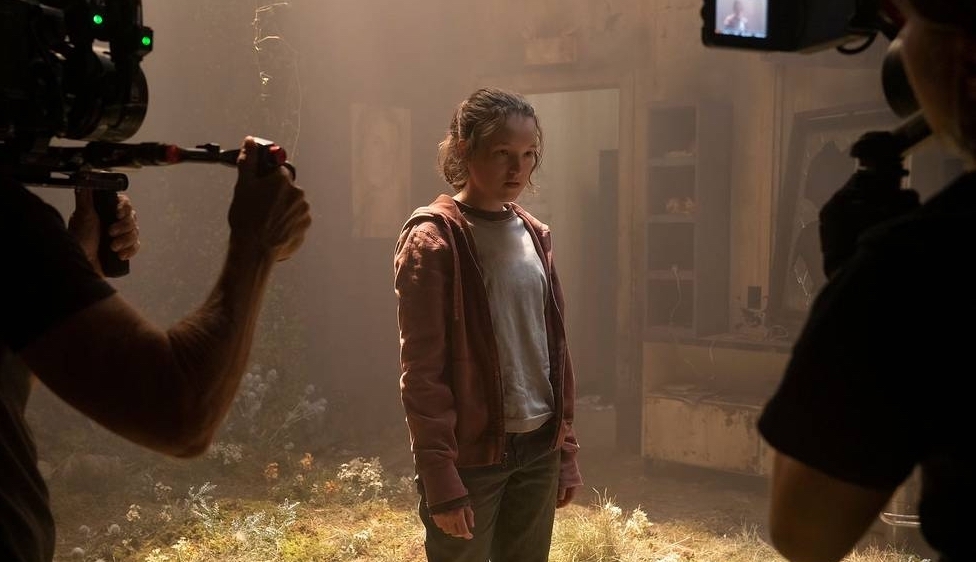
The Last of Us is centered on a hardened, resourceful smuggler named Joel (a terrific Pedro Pascal) who, like every other adult who has survived the Cordyceps plague, lives with the memories of those he lost in a constant, exhausting state of alarm. In Joel’s case, he lost his daughter, Sarah (Nico Parker), during the first blush of the plague’s spread, when a soldier was ordered to shoot her for fear she might be infected. Years later, he finds himself tasked with a very unusual smuggling job; get some special cargo out of the Quarantine Zone in Boston and deliver it to a group of people who believe very strongly in the cargo’s importance to fighting the plague. The cargo has a name—Ellie (an equally terrific Bella Ramsey)—and she might hold the key to defeating the plague in her veins. Their journey, fraught and frightening, is the backbone of season one.
This narrative conceit also presented Paino with unusual challenges, as the story dictates that Joel and Ellie are never in the same place twice, tasking him with the responsibility of creating fresh ruins for them to explore and often flee.
“We never repeated anything,” Paino says. “Joel and Ellie are going from A to Z, so everything they’re passing through is new. I think we had 180 locations, and we built somewhere to the north end of 90 sets.”
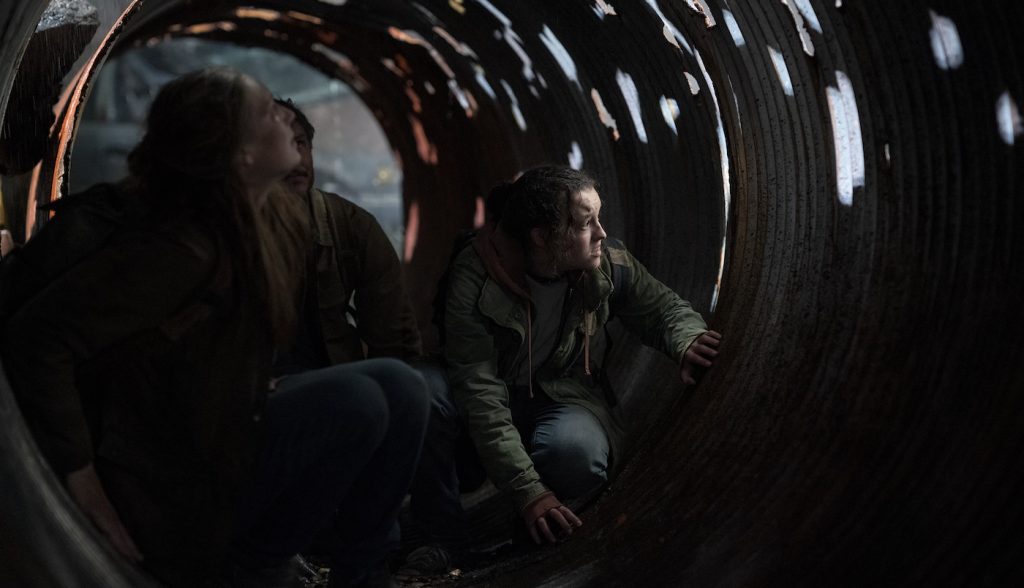
As Joel and Ellie move west from the QZ in Boston across the living nightmare of post-plague America, they run afoul of increasingly bizarre and grotesquely beautiful variations of the infected. They also bear witness to the reclamation of manmade structures by nature. In this case, a berserk, murderous nature. Some of Paino’s design choices were inspired by the Cordyceps fungi itself.
“[The sets] are evocative of this new lifeform which very well may take over the planet and which comes from this plant-based plague,” Paino says. Yet co-creator Craig Mazin was clear from the jump that they weren’t making “disaster porn.” “It’s hard because there is this point where the natural world has very much taken over society, the architecture, civilization as a whole. Especially through Ellie’s eyes, having never been outside the QZ, there is a kind of awe with all of that. As adults, Joel and Tess [Anna Torv] are very much aware of how dangerous this world is, so it wouldn’t be a surprise to them, but it’s a surprise to Ellie and the viewer, so we wanted to play with that. We didn’t want to make it too beautiful, but it is beautiful.”
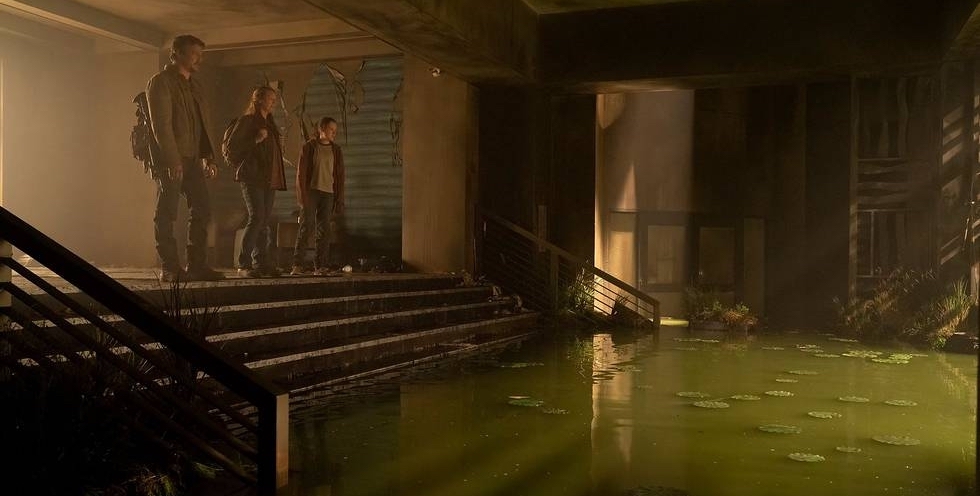
The beauty and the horror are locked in a deathly embrace in The Last of Us in a way that’s unusual for a show about the living dead. That becomes apparent during the second episode, “Infected,” when Joel, Ellie, and Tess make it out of the QZ and have to pick their way through a museum. It’s here they come across a sub-species of the infected known, un-scientifically but evocatively, as “clickers.” This variation of zombie (in the third stage of their infection according to The Last of Us wiki) enjoy a unique kind of migraine—their skulls have been exploded open by the fungus, which fans out on either side of their head with a gruesome panache that would have made H.R. Giger blush. What’s left of their faces is basically the lower jaw and a row of jagged teeth. They earn their nickname by moving via echolocation (producing a clicking sound) towards their prey.
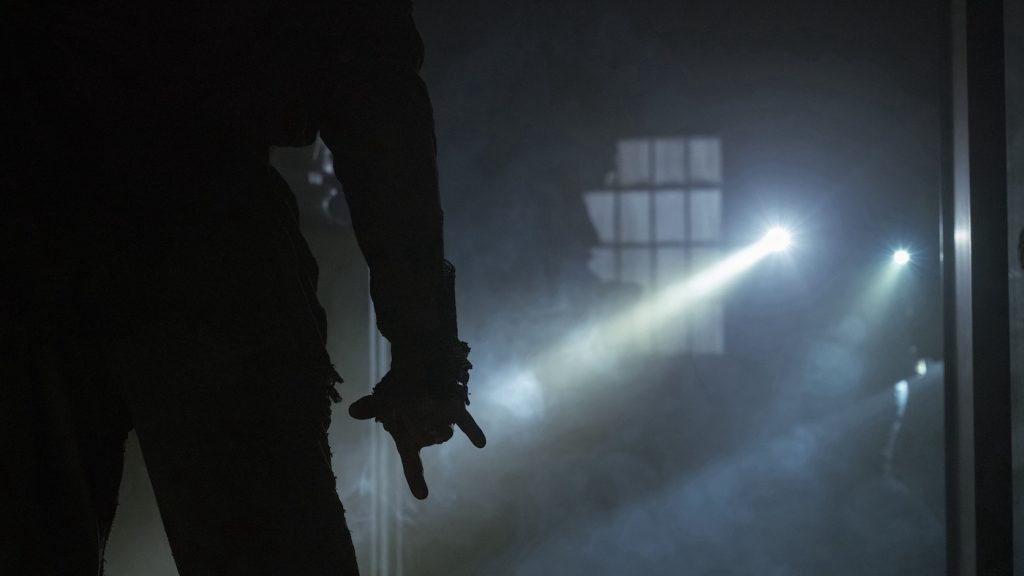
During the episode, two clickers hone in on our heroes, and what follows is a deliciously terrifying chase through the museum. Paino and his team pored over every little detail to ensure the place looked just right, even though his most brilliant stroke never made it to the screen.
“We had this incredible commemorative Revolutionary War tea set that the fungus was growing through,” he says. “At one point, Joel side glances this tea set, and that was our nod to the line between the civilization and history and how the fungus and infected have grown through it, literally and metaphorically. The infected don’t care; they’re just going to go everywhere.”
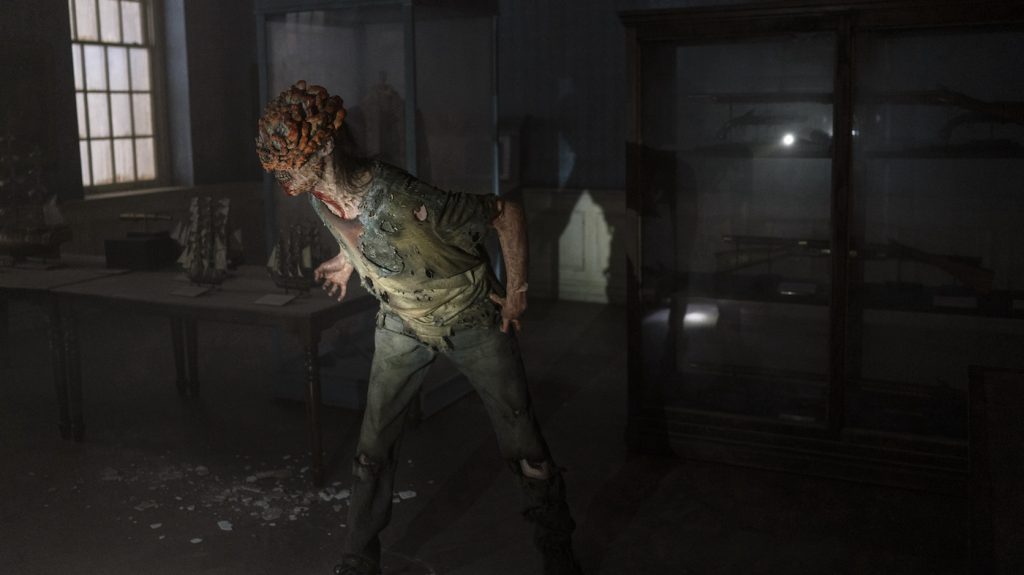
As for the design of the clickers themselves and the hordes of the ingeniously infected who haunt the series, Paino points to prosthetics designer Barrie Gower. “That’s totally his wheelhouse,” he says. “Our thing was making sure we had some interesting things for the Cordyceps to grow through, like that the museum in Boston. Working with the infected and creature effects, it was about making sure that the creatures either came out of our environments or really popped against them with the colors we chose.”
Paino says that despite the continental sweep of The Last of Us, following Joel and Ellie’s journey for thousands of miles, the series rarely makes use of green screens to fill in backgrounds digitally. “Most of the interiors are built and the locations are dressed,” he says. For the sets and locations, only visuals like two ruined skyscrapers leaning against each other, frozen in mid-collapse by their mutual support, are one hundred percent VFX.
One of the most memorable builds for Paino and his team, and one of the best episodes of television this year (or any other, if you ask me), was for episode three, “Long, Long Time,” which shifted the focus from Joel and Bella’s journey to a skilled if lonely doomsday prepper named Bill (Nick Offerman) and his shock at finding a starving man named Frank (Murray Bartlett) begging, from the bottom of a hole Bill had covered to trap would-be intruders, for a little food. The episode, which spans years, tracks their relationship inside Bill’s compound which, thanks to Frank, becomes a home.
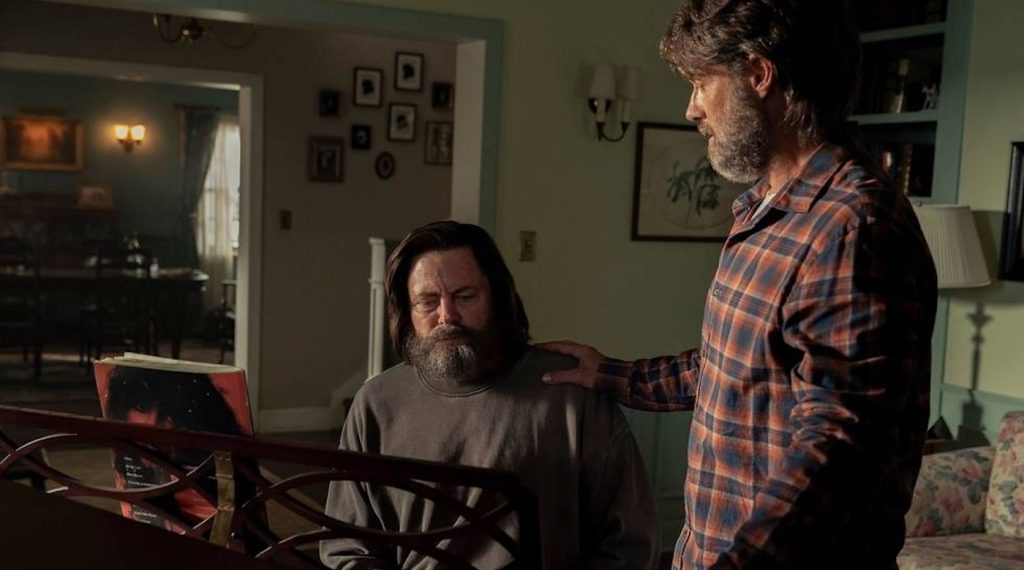
“When I read the script, I immediately emailed Craig and said it’s one of the best I’ve ever read,” Paino says. “It’s just haunting and beautiful. And it was so great to have a respite, because it’s a show where you don’t really stop; you don’t get to dig into people’s lives and flesh out their personalities and characters. But in episode three, we were able to, and it was really great from a design and art point of view. It was really wonderful.”
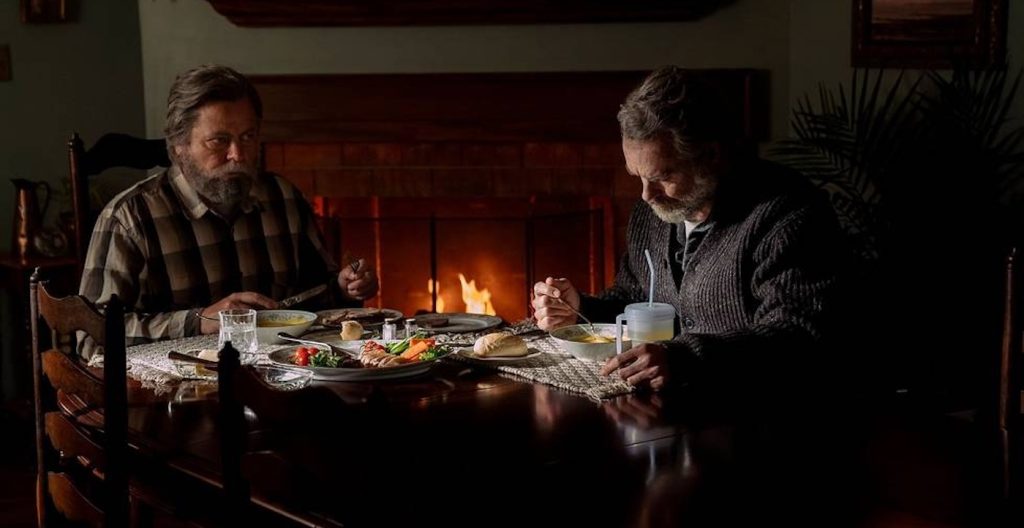
Designing Bill and Frank’s house required adding little touches that turned what was a booby-trapped, heavily fortified suburban fortress into a place where two men fell in love and lived their lives in the most darkly romantic setting possible. Frank, an amateur artist, begins populating the walls of the house with his portraits of Bill.
“It was a little difficult to land on how talented Frank was,” Paino says. “It was also important to make sure that we showed his skills degrading, even though it’s never said what exactly his degenerative disease is, whether it’s Parkinson’s or MS, that would certainly effect his ability to paint. And the actors were just so great. Murray Bartlett as Frank, you could see his mind wander as his illness takes hold. He did such a great job of showing his cognitive skill decaying.”
One of the biggest challenges for Paino was doubling Calgary’s architecture, where The Last of Us was filmed, for some of the American locations. “We’re going from the east coast of America to the west coast, and there wasn’t a lot of appropriate architecture in Calgary,” Paino says. “Once we get to the middle of America and the middle of our journey, on the vast plains, Calgary was great for that. But when we were in the cities, that’s where the challenges were.”
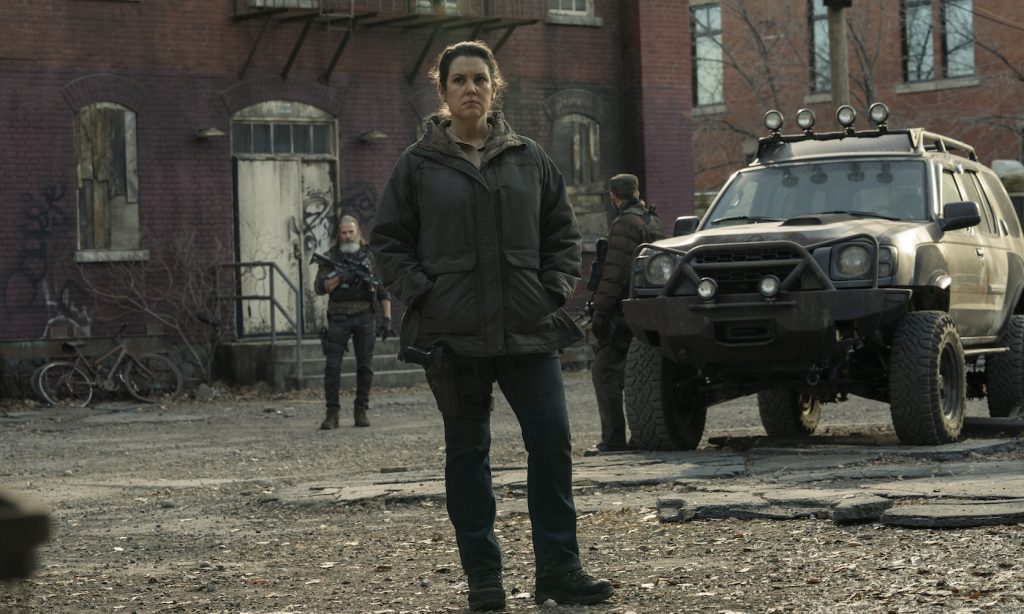
Those challenges included imagining what a world that hadn’t had a functioning electrical grid, or any reliable infrastructure, for decades.
“Nothing has worked for 20 years, and nature has claimed things, so finding locations where we were able to give that much desiccation was our biggest challenge,” Paino says. “It’s really hard to break things down like that, actual places where people to go to work in. So making sure we had the time not only had the time do that, but then restore the location, that was hard.”
Whether Joel and Ellie were fighting for their lives in a museum, a laundromat in Kansas City, or a suburban culdesac outside of it, much of what you see in The Last of Us are real places turned into ruins by Paino and his team. For the climatic battle in the suburban culdesac towards the end of episode 5, Paino built the set in a parking lot adjacent to one of their stages. The scene saw Joel, Ellie, and two new (and brief) fellow travelers, Henry (Lamar Johnson) and Sam (Keivonn Woodard), beset by a group of rebel humans led by Melanie Lynskey’s Kathleen, who unleashes her vast amount of firepower in an effort to punish Henry for a past transgression. Things look bleak for our heroes when it’s just human vs human, but this is a world where humans no longer rule. Cue a truck that explodes and falls into a sinkhole, unleashing a horde of infected that includes a “bloater,” a massive zombie in the final stages of infection. (The show’s cultural impact is such that you can even test your knowledge of the various stages of zombification via Elle Magazine, not an outlet you’d usually associate with keen-eyed analysis of the varietals of the living dead.)
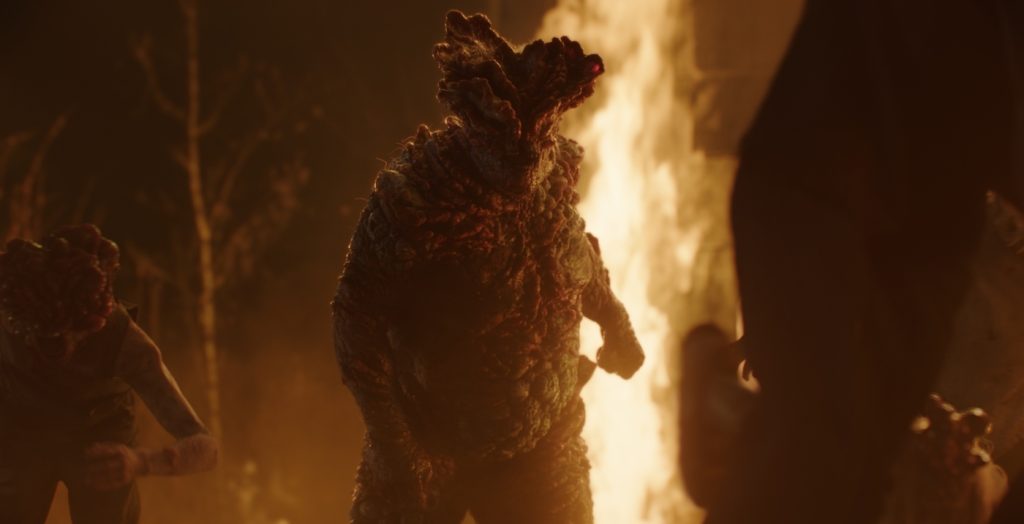
“It was one and a half acres in length and at least as wide as an acre,” Paino says. “It had 13 houses on it, including the three story sniper house. After a lot of planning, we picked which house the truck would crash into, then rigged that structure to collapse when the truck ran into it. Flame units and explosive charges went off at the moment of impact. The truck was then moved and the hole was created and made safe for the extras who were made up as the infected to emerge. We added ladders and ramps to facilitate them moving quickly.”
It’s riveting television, designed by Paino down to the very last fungal tendril creeping along the cracked floors and up the walls. It’s a nightmare vision of the planet, all the more heartbreaking for still being so beautiful.
For more on The Last of Us, check out these stories:
“The Last of Us” Cinematographer Eben Bolter on Episode 4 & More
How “The Last Of Us” Episode 3 Departed From The Game in a Beautiful, Heartbreaking Way
HBO’s “The Last Of Us” Delivers Astonishing Second Ep For Largest-Ever Viewership Growth
Featured image: Bella Ramsey and Pedro Pascal. Photograph by Liane Hentscher/HBO



